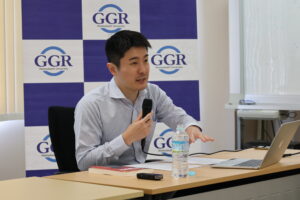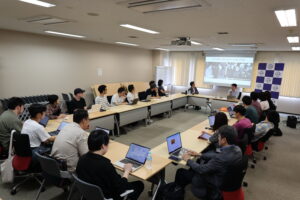On May 21, 2025, the Institute for Global Governance Research (GGR) at Hitotsubashi University hosted a Talk Session titled “People’s Diplomacy: How Americans and Chinese Transformed U.S.–China Relations during the Cold War” featuring Kazushi Minami, Associate Professor, Graduate School of International Public Policy, Osaka University.
Dr. Minami began his talk by discussing the tense U.S.–China relations of the 1970s. A turning point came in February 1972, when President Nixon made a historic visit to China, meeting Chairman Mao and Premier Zhou Enlai. This visit led to the Shanghai Communiqué, which laid the foundation for normalizing diplomatic ties, formally achieved seven years later.
He then introduced the concept of people’s diplomacy,diplomatic efforts led by individuals or nonstate actors rather than governments. Unlike public diplomacy, which is state-directed, people’s diplomacy involves grassroots exchanges in fields such as culture, education, science, and sports. A famous example is the 1971 Ping-Pong Diplomacy, where friendly interactions between American and Chinese players helped reduce tensions and opened the door to formal diplomatic talks. China institutionalized this approach, known as renmin waijiao, using citizen diplomacy to build international goodwill.
People’s diplomacy plays a vital role in humanizing international relations, building trust, and opening communication channels when official relations are strained. It demonstrates that diplomacy is not only the domain of states, but also shaped by individuals and communities. Dr. Minami highlighted three key areas of people’s diplomacy: trade, tourism, and sports. On trade, he explained that although commerce between China and the U.S. had halted after the 1949 embargo, American business leaders in the 1970s advocated reopening ties. Nixon’s 1972 visit spurred renewed trade, and China welcomed U.S. technology as part of its modernization agenda. Tourism also played a diplomatic role. Western fascination with China dates back to Marco Polo, but during the 1970s, travel to China shifted from political propaganda to economic development. Deng Xiaoping opened China to foreign tourism, seeking hard currency and modernization. American tourists began engaging with locals, reshaping China’s global image. In sports, Ping-Pong Diplomacy showcased how athletic exchanges could promote peace. Chinese athletes acted as informal ambassadors during their 1972 U.S. visit, sometimes even losing games to promote friendship.
During the Q&A there was a question about the driving force behind people’s diplomacy and its relation to diversity, noting the many spontaneous interactions and shifts. The speaker replied that people’s diplomacy in the 1970s was driven by China’s desire for U.S. technology and modernization, U.S. business interest in China’s market, and scientific collaboration. These diverse motivations fostered mutual benefit. Dr. Minami concluded that including varied actors in diplomacy reveals the deeper, more complex nature of U.S.–China relations: diverse and multifaceted both then and now.
[Event report prepared by] Billal Hossain (Doctoral student, Graduate School of Law, Hitotsubashi University) |
 |
